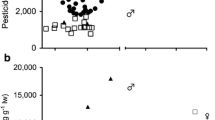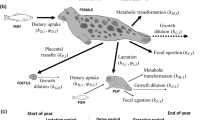Abstract
This study uses an individual-based contaminant bioaccumulation model for marine mammals to explore factors controlling the transfer of PCBs from mother to calf via nursing in beluga from the St. Lawrence Estuary. Beluga blubber samples (n = 46), along with four matched milk samples from stranded animals over the 1986–1994 period were used for comparison with modelled results. Based on 68 POPs, including 48 PCBs and 20 other organochlorine compounds, milk:blubber ratios were 0.65 between log K OW 3–6.5, then decreased to 0.1 at log K OW 8. Model simulations based on this relationship indicated females were transferring PCBs that were relatively very hydrophobic and highly chlorinated less readily than their lower chlorinated counterparts, resulting in an enriched concentration of very hydrophobic congeners in nursing females relative to adult males. There was very good agreement between observed and modelled male:female PCB concentration ratios. Four females within our dataset (15 %) had male-like ΣPCB concentrations as well as male-like congener profiles, suggesting that these individuals may have had a reduced or limited nursing history.





Similar content being viewed by others
References
Addison RF, Brodie PF (1987) Transfer of organochlorine residues from blubber through the circulatory-system to milk in the lactating gray seal (Halichoerus grypus). Can J Fish Aquat Sci 44:782–786
Béland P, De Guise S, Plante R (1992) Toxicology and pathology of St. Lawrence marine mammals. Wildlife Toxicology Fund Report (unpublished). World Wildlife Fund, Toronto, Ontario
Béland P, De Guise S, Girard C, Lagacé A, Martineau D, Michaud R, Muir DCG, Norstrom RJ, Pelletier E, Ray S, Shugart LR (1993) Toxic compounds and health and reproductive effects in St-Laurence beluga whales. J Great Lakes Res 19:766–775
Boon JP, van der Meer J, Allchin CR, Law RJ, Klungsoyr J, Leonards PEG, Spliid H, Storr-Hansen E, Mckenzie C, Wells DE (1997) Concentration dependant changes of PC patterns in fish-eating mammals: structural evidence of induction of Cytochrome P450. Arch Environ Contam Toxicol 33:298–311
Brodie PF (1971) A reconsideration of aspects of growth, reproduction, and behavior of the white whale (Delphinapterus leucas), with reference to Cumberland Sound, Baffin Island, population. J Fish Res Board Can 28:1309–1318
Burkhard LP, Kuehl DW, Veith GD (1985) Evaluation of reverse phase liquid-chromatography mass-spectrometry for estimation of n-octanol water partition coefficients for organic-chemicals. Chemosphere 14:1551–1560
De Guise S, Lagacé A, Béland P, Girard C, Higgins R (1995) Nonneoplastic lesions in beluga whales (Delphinapterus-leucas) and other marine mammals from the St-Lawrence estuary. J Comp Pathol 112:257–271
Desforges J-PW, Ross PS, Loseto LL (2012) Transplacental transfer of polychlorinated biphenyls and polybrominated diphenyl ethers in Arctic beluga whales (Delphinapterus leucas). Environ Toxicol Chem 31:296–300
Hammill MO, Measures LM, Gosselin J-F, Lesage V (2007) Lack of recovery in St. Lawrence Estuary beluga. DFO Can Sci Advis Secr Res Doc 2007/026. p vi+19
Heide-Jørgensen MP, Teilmann J (1994) Growth, reproduction, age structure and feeding habits of white whales (Delphinapterus leucas) in West Greenland waters. Medd Grønl Biosci 39:195–212
Hickie BE, Mackay D, de Koning J (1999) Lifetime pharmacokinetic model for hydrophobic contaminants in marine mammals. Environ Toxicol Chem 18:2622–2633
Hickie BE, Kingsley MCS, Hodson PV, Muir DCG, Béland P, Mackay D (2000) A modelling-based perspective on the past, present, and future polychlorinated biphenyl contamination of the St. Lawrence beluga whale (Delphinapterus leucas) population. Can J Fish Aquat Sci 57(Suppl 1):101–112
Hickie BE, Muir DCG, Richard FA, Hoekstra PF (2005) Development and application of bioaccumulation models to assess persistent organic pollutant temporal trends in arctic ringed seal (Phoca hispida) populations. Sci Total Environ 351(352):413–426
Hickie BE, Ross PS, Macdonald RW, Ford JKB (2007) Killer whales (Orcinus orca) face protracted health risks associated with lifetime exposure to PCBs. Environ Sci Technol 41:6613–6619
Hickie BE, Cadieux MA, Riehl KN, Bossart GD, Alava JJ, Fair PA (2013) Modeling PCB-bioaccumulation in the Bottlenose Dolphin (Tursiops truncatus): estimating a dietary threshold concentration. Environ Sci Technol 47:12314–12324
Hobbs KE, Muir DCG, Michaud R, Béland P, Letcher RJ, Norstrom RJ (2003) PCBs and organochlorine pesticides in blubber biopsies from free-ranging St. Lawrence River Estuary beluga whales (Delphinapterus leucas), 1994-1998. Environ Pollut 122:291–302
Howard PH (1991) Handbook of environmental fate and exposure data for organic chemicals, vol III-Pesticides. CRC Press, Boca Raton, FL
Lauer BH, Baker BE (1969) Whale milk. I. Fin whale (Balaenoptera physalis) and beluga whale (Delphinapterus leucas) milk: gross composition and fatty acid constitution. Can J Zool 47:95–97
Lebeuf M, Nunes T (2005) PCBs and OCs in sediment cores from the lower St. Lawrence estuary, Canada: evidence of fluvial inputs and time lag in delivery to coring sites. Environ Sci Technol 39:1470–1478
Lebeuf M, Noël M, Trottier S, Measures L (2007) Temporal trends (1987-2002) of persistent, bioaccumulative and toxic (PBT) chemicals in beluga whales (Delphinapterus leucas) from the St. Lawrence Estuary. Canada. Sci Total Environ 383:216–231
Loseto LL, Stern GA, Deibel D, Connelly TL, Prokopowicz A, Lean DRS, Fortier L, Ferguson SH (2008) Linking mercury exposure to habitat and feeding behaviour in Beaufort Sea beluga whales. J Mar Syst 74:1012–1024
Markussen NH, Ryg M, Øritsland NA (1990) Energy-requirements of maintenance and growth of captive harbor seals, Phoca vitulina. Can J Zool 68:423–426
Martineau D, Béland P, Desjardins C, Lagacé A (1987) Levels of organochlorine chemicals in tissues of beluga whales (Delphinapteris leucas) from the St. Lawrence Estuary, Quebec, Canada. Arch Environ Contam Toxicol 16(2):137–147
Martineau D, De Guise S, Fournier M, Shugart L, Girard C, Lagacé A, Béland P (1994) Pathology and toxicology of beluga whales from the St, Lawrence Esuary, Québec, Canada—Past, present, and future. Sci Total Environ 154(2–3):201–215
Martineau D, Lemberger K, Dallaire A, Labelle P, Lipscomb TP, Michel P, Mikaelian I (2002) Cancer in wildlife, a case study: beluga from the St. Lawrence estuary, Québec, Canada. Environ Health Perspect 110:285–292
McLachlan MS (1994) Model of the fate of hydrophobic contaminants in cows. Environ Sci Technol 28:2407–2414
Michaud R, Béland P (2001) Looking for trends in the endangered St. Lawrence beluga population: a critique of Kingsley, MCS 1998. Population index estimates for the St. Lawrence belugas, 1973-1995. Mar Mammal Sci 14:508-530. Mar Mammal Sci 17(1):206-212
Muir DCG, Ford CA, Stewart REA, Smith TG, Addison RF, Zinck ME, Béland P (1990) Organochlorine contaminants in belugas, Delphinapterus leucas, from Canadian waters. In: Smith TG, St. Aubin DJ, Geraci JR (eds) Advances in research on the beluga whale, Delphinapterus leucas, vol 224. Department of Fisheries and Oceans, Ottawa, pp 165–190
Muir DCG, Ford CA, Rosenberg B, Norstrom RJ, Simon M, Béland P (1996a) Persistent organochlorines in beluga whales (Delphinapterus leucas) from the St. Lawrence River estuary. 1. Concentrations and patterns of specific PCBs, chlorinated pesticides and polychlorinated dibenzo-p-dioxins and dibenzofurans. Environ Pollut 93:219–234
Muir DCG, Koczanski K, Rosenberg B, Béland P (1996b) Persistent organochlorines in beluga whales (Delphinapterus leucas) from the St Lawrence River estuary 2. Temporal trends, 1982-1994. Environ Pollut 93:235–245
Norstrom RJ, Muir DCG (1994) Chlorinated-hydrocarbon contaminants in arctic marine mammals. Sci Total Environ 154:107–128
Oftedal OT (2000) Use of maternal reserves as a lactation strategy in large mammals. Proc Nutr Soc 59:99–106
Ognetov GN (1990) Changes in the body condition of white whales (Delphinapterus leucas) in the White and Kara seas. Rep Int Whal Commn 40:477–479
Øritsland NA, Markussen NH (1990) Outline of a physiologically based model for population energetics. Ecol Modell 52:267–288
Ronald K, Keiver KM, Beamish FWH, Frank R (1984) Energy-requirements for maintenance and fecal urinary losses of the grey seal (Halichoerus grypus). Can J Zool 62:1101–1105
Ross PS, de Swart RL, Reijnders PJH, Vanloveren H, Vos JG, Osterhaus A (1995) Contaminant-related suppression of delayed-type hypersensitivity and antibody responses in harbour seals fed herring from the Baltic Sea. Environ Health Perspect 103(2):162–167
Routti H, Letcher RJ, Arukwe A, van Bavel B, Yoccoz NG, Chu SC, Gabrielsen GW (2008) Biotransformation of PCBs in relation to phase I and II xenobiotic-metabolizing enzyme activities in ringed seals (Phoca hispida) from Svalbard and the Baltic Sea. Environ Sci Technol 42(23):8952–8958
Sormo EG, Skaare JU, Lydersen C, Kovacs KM, Hammill MO, Jenssen BM (2003) Partitioning of persistent organic pollutants in grey seal (Halichoerus grypus) mother-pup pairs. Sci Total Environ 302:145–155
Stern GA, Muir DCG, Segstro MD, Dietz R, Heide-Jørgensen MP (1994) PCBs and other organochlorine contaminants in white whales (Delphinapterus leucas) from west Greenland: variation with sex and age. Medd Grønl Biosci 39:245–259
Stewart REA, Lavingne DM (1984) Energy transfer and female condition in nursing harp seals Phoca groenlandica. Holarct Ecol 7:182–194
Stewart REA, Campana SE, Jones CM, Stewart BE (2006) Bomb radiocarbon dating calibrates beluga (Delphinapterus leucas) age estimates. Can J Zool 84:1840–1852
Subramanian AN, Tanabe S, Tatsukawa R (1988) Use of organochlorines as chemical tracers in determining some reproductive parameters in Dalli-type Dall’s porpoise Phocoenoides dalli. Mar Environ Res 25:161–174
Suntio LR, Shiu WY, Mackay D (1988) A review of the nature and properties of chemicals present in pulp-mill effluents. Chemosphere 17:1249–1290
Vanier C, Sylvestre M, Planas D (1996) Persistence and fate of PCBs in sediments of the Saint Lawrence River. Sci Total Environ 192:229–244
White RD, Hahn ME, Lockhart WL, Stegeman JJ (1994) Catalytic and immunochemical characterization of hepatic-microsomal cytochromes P450 in beluga whale (Delphinapterus leucas). Toxicol Appl Pharmacol 126:45–57
Yordy JE, Wells RS, Balmer BC, Schwacke LH, Rowles TK, Kucklick JR (2010) Life history as a source of variation for persistent organic pollutant (POP) patterns in a community of common bottlenose dolphins (Tursiops truncatus) resident to Sarasota Bay, FL. Sci Total Environ 408:2163–2172
Acknowledgments
This research was supported in part by funding from Fisheries and Oceans Canada, Aboriginal Affairs and Northern Development Canada—Northern Contaminants Program, and by a Canadian Natural Sciences and Engineering Research Council Discovery Grant to BEH. Sample collection and analysis were supported by the Wildlife Toxicology Fund, a joint initiative of the World Wildlife Fund Canada and Environment Canada; by Fisheries and Oceans Canada under the St. Lawrence Action Plan, Alcan; the Foundation de la Faune du Quebec; Environnement Quebec and Greenpeace (Canada); and to one of the authors (PB). The authors thank Bruno Rosenberg (Fisheries and Oceans, Winnipeg) for analysis of the milk and blubber samples.
Author information
Authors and Affiliations
Corresponding author
Electronic supplementary material
Below is the link to the electronic supplementary material.
Rights and permissions
About this article
Cite this article
Cadieux, M.A., Muir, D.C.G., Béland, P. et al. Lactational Transfer of Polychlorinated-Biphenyls (PCBs) and Other Organochlorines in St. Lawrence Beluga Whales (Delphinapterus leucas). Arch Environ Contam Toxicol 70, 169–179 (2016). https://doi.org/10.1007/s00244-015-0223-y
Received:
Accepted:
Published:
Issue Date:
DOI: https://doi.org/10.1007/s00244-015-0223-y




